The Era of the Wild Boar
... we begin to emerge as the solutions that we are.
Marie Edwards
At Imbolc, the first of the seasonal celebrations, which is generally on or around the beginning of February, we herald the end of Winter and the beginning of Spring. The days gradually begin to lengthen, and the first stirrings of life are called forth. Our planetary and local situations are also calling for us to continue to work together in mapping out another way of being. This is the time in which we must become more visible in our commitment to serving Life in all of its complexity. As we observe in nature, the land, plants, trees, mycelium, animals and insects work together in various ways to support and enable each other. A dynamic balance is kept that ensures the mutual flourishing of everything. This is how we must operate with each other as human beings if we are to be successful in establishing cooperative and harmonious connections and relationships.
Angus (in his wisdom) recently changed the symbol of our Northern School PDC courses to the ‘Wild Boar’, as beautifully illustrated on our new completion certificates.
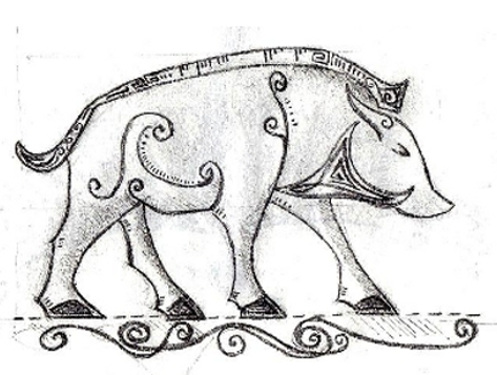 |
 |
Some of you may be wondering about this creature and why it should emerge now. Wild boars are understood to be able to hold their ground steadfastly, given their robust connection with the earth. Their innate dedication to making a path, finding a way through and moving beyond difficulties is admirable. The Wild Boar is a fearless guide through adversity, trials and tribulations. In observing the power of wild boar, we can recognise our own ability to strive for change amidst challenging conditions. They encourage us to uncover our own self-reliance, resilience and tenacity. Wild boars are also able to engage with acts of ferocious self-protection and preservation when necessary.
The wild boar that have repopulated and contributed to the re-wilding of the Scottish and English forests fascinatingly managed to do this solely by themselves, by escaping from captivity! This has occurred a number of times in the UK since the 1970’s. It seems that they refuse to be held back from reconnecting with their wild nature. They are known for their rooting and foraging sensibilities as they overturn the topsoil, leaves and organic debris, uncovering invertebrates which are then duly feasted on by nearby birds. Unsurprisingly, wild boar subsequently have a significant impact on the woodland ecosystem, dispersing tree seeds, mixing soil nutrients, increasing plant biodiversity. In fact, since this timely re-infiltration of our forests, wild boar appear to have developed a symbiotic relationship with one of our Imbolc messengers and companions, the robin. Many a gardener will have noticed the focussed attention of robins when any earth is overturned (obviously as permaculture designers we tend to build and cover soil rather than expose it) nonetheless they do have a habit of appearing just as any clearing is taking place. They love to forage on any disturbed worms and insects that dwell close to the surface.
Robins are understood to embody a promise of new beginnings and regeneration after loss. A potent symbol of Spring and new growth, robins remind us that we can sing a new reality into being with joy in our hearts. For those who may have been stricken with grief in relation to our current ecological crisis the evident companionship between robin and wild boar may prove an encouraging sign when we see it. I wonder if their synergy will assist us is in re-establishing the ecological balance and diversity that our landscapes so desperately need. Wild boar can also be associated with the energies of fertility and abundance. Their keen sense of smell allows them to seek out the nutrients that they require without fail. A relentless, wild, primal power that does not give up, yet is able to sustain itself whilst navigating the dense woodland terrain. A power worth working with as we move into deeper service and commitment to Life, supporting the reparation and renewal of our world.
Wishing you a fruitful and courageous 2020! May we be as the Boar.
Sources:
Britain’s Wild Boar – Inside Ecology
Rewilding: Wild Boar and Robin - Trees for Life
Marie Edwards is a certified permaculture designer and our Editor at Northern Edge
| On the move... |
 |
‘In-Tune’ with Nature
Krysia Soutar
Observing Nature's patterns
Here we are again, in the quiet contemplative time of winter. I have written in a previous issue about how energy changes in the winter, as part of Nature’s yearly cycle. As I mentioned before, winter is associated with the element of Water, the organs associated with this element are the Kidneys and Bladder.
”The kidney, the most precious and faithful of our organs, is the chemist of the body. An accurate chemist who never pauses for rest”. From George Oshawa writing about our wonderful kidneys.
Our kidneys function night and day to filter impurities from the blood and discharge excess waste from the body. They are our most biologically complex and wonderfully designed organs. We owe them a lot and should take great care of them.
Our modern way of life and diet gives the kidneys much work to do. Traditional Oriental Medicine shows some insight into how kidney problems might develop. The kidneys may begin to become swollen, the delicate kidney tissues may become blocked, the kidneys may become exhausted.
According to the study of Traditional Oriental Medicine, signs that may be seen are:
- Darkness of the delicate tissues around the eye
- Swollen bags under the eyes.
- Fatty deposits underneath the eye
There are other signs if you wish to study this further, I can recommend the The Macrobiotic Path to Total Health by Michio Kushi and Alex Jack.
Foods that support the kidneys
- Aduki beans are particularly valued - see winter 2018 issue
- All other beans
- Raw grated white radish (also known as mooli or daikon), served as a condiment - helps to remove stagnation of fats in the kidneys.
- Sea vegetables.
Things that can harm them
- Too much salt.
- High amounts of saturated fats
- Too many fluids of all kinds
- Some medication/drugs
- Chemical pollutants.
Home Remedies
- Hot ginger towels placed on lower back area (I will give more information about this in a later issue).
- Keep kidney area warm - for example, hot water bottles
- Rest
Winter in the northern hemisphere
Eating ‘in tune with nature ‘means eating foods which are as far as possible grown near to where you live or from a similar latitude. In this way we are hopefully not transporting our food too far. We are also benefiting energetically from eating foods adapted to our climate. It is going against nature to eat foods such as pineapple (from a tropical region and therefore suitable for a hot climate) in the middle of winter, far away from the equator. We may become cold and our kidneys will suffer as a result.
We live in the West Pennine hills of Lancashire, close to the, moors, it can be cold, damp and windy during the wintertime. We usually have snow and ice, but we have not seen any so far this year. As there is reduced daylight, and a dark environment due to the surrounding hills, it can feel a little depressing. Due to the lack of sunlight we have health problems in the region linked to vitamin D deficiency, so as a preventative measure we take a vitamin D supplement during the winter months. I prefer to take a vegan vitamin D spray which does not contain any gelatine. It is also advisable to go outside for a walk in the fresh air and gain whatever sunlight is available.
There is little growing in our environment during this season, so we tend to eat more fermented vegetables such as pickles and sauerkraut at this time of year, and as many green vegetables and root vegetables as available.
Ideally, it is wonderful to have a large cool food storage area on the North side of the house, (usually the coolest side). Our front door faces north so we make use of our inner porch area as a pantry. We use an old bookcase to store a variety of jars of beans, grains, seeds, pickled vegetables, also our wine and beer.
It functions very well, and it looks good as I have hung little fairy lights to make it look nice! I am considering making this area bigger as I want to store more food products and it is becoming a bit cramped. Permaculture design for a pantry area!
In the days before refrigeration, most properties would have had their pantry area in the coolest part of the house, usually with a big stone slab. Meat would have been bought locally, usually once a week, fish would also have been bought locally again usually once a week. Vegetables and fruits would all come from the locality. Tropical spices and sugar would not have been readily available.
Winter Recipe
The recipe for this winter issue is taken from a book called Conscious Cookery by Suzanne Saunders. I was amazed when I found this book as it is so ‘in tune’ with my own journey and understanding of seasonal energy change, and how our daily choice of food and way of cooking helps to create our health and emotional well-being.
Suzanne and her husband Phil run Sunny Brow Farm Holistic Retreat near Ambelside in the Lake District. I hope to provide more information about them in our Enterprise section in a future edition:
Red Dragon Pie
 |
 |
Recipe source from ‘ Conscious Cookery’ by Suzanne Saunders
Serves 6-8:
- 2 cups aduki beans, soaked in 6 cups water
- 1 Large Onion
- 1 Large carrot, diced
- 1-2 cups celery, diced
- 1 clove garlic, cut finely
- 2 tsp mixed herbs
- ½ squash, cut into small chunks [optional}
- 1 tin tomatoes [ or 1 cup home-made ‘tomato’ sauce ]
Seasonings: 2 tbsp shoyu and 1 tbsp apple concentrate Pie top:
- 1 ½ cup millet
- 4-5 small potatoes, cut into small chunks
- 4 cups water
- 2-3 tbsp olive oil
Method
Cook the aduki beans by bringing then to boil, in their soaking water, skim off any froth from the top, and add a piece of kombu sea vegetable . Cover and turn to simmer, and cook gently for approx 45 minutes. Saute the onions, carrot and celery in a little olive oil for 5 minutes; add a pinch of salt, the garlic and mixed herbs, and saute for a further 5 minutes. Add this mixture to the beans, with the tomato and squash if you are using. Cook the whole mixture for another 25 minutes, adding a little more water if it gets too dry. Add the seasonings and place in an oven proof dish. As the beans are cooking, in another large pan, toast the millet grain, add the water, potatoes and salt and bring to the boil. Turn down to very low, cover with lid, place on a flame spreader and cook for 20 – 25 minuets or until all the water is absorbed and the millet and potatoes are soft. Add the olive oil, and mash until smooth. Cover the bean mixture with the millet and potato mash, and bake in hot oven (200 degrees C) for 25 minutes, or until golden and bubbling.
Krysia Soutar, CertEd, has the Diploma in Applied Permaculture Design and teaches Permaculture Design. She is a health coach, qualified to Kushi Institute Level 2.
Deep Winter Roots
Edwina Hodkinson
Comfrey Root – Symphytum officinale
It’s still winter, nature is asleep with much of life beneath the ground. The trees are bare, and what’s left of last year’s herbs are now dry, dead stalks ready for clearing back to allow for new growth in spring. The days lighten ever so slightly, and I notice the birds starting to sing in the morning. Getting out my spade I dig, there is medicine to harvest from under the soil. Deep, dark roots, that can bring deep healing to the body when made into medicines. I’m glad that I know what’s growing in my garden, otherwise it would be hard to find and identify the herbs from the roots alone. The comfrey is now completely hidden but I find its roots feel very familiar from the mucilaginous feel when cut. The Horseradish and Elecampane have a distinctive aroma, released when I slice through the root, powerful and aromatic. The Elecampane is fragrant and the Horseradish makes my eyes water. This is due to the volatile oils concentrated in the root. The Dandelions have a small rosette of green shoots which I nibble and save for a salad after I clean them and slice off the taproot, which I then I chop up and dry in the dehydrator ready to dry roast for Dandelion coffee.
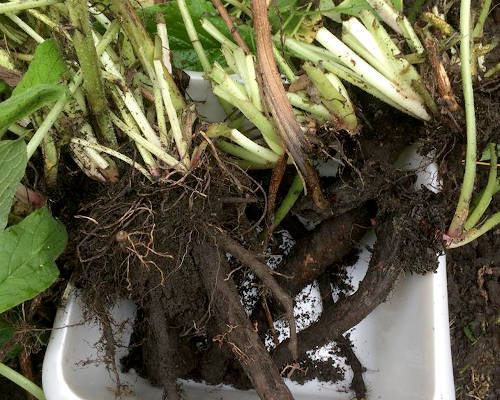 |
| Comfrey Root – Symphytum officinale |
 |
Comfrey is an invaluable herbal remedy, and one of the last medicinal plants to remain in the folk memory of older people which they know as “Knit bone.” There are local stories of people remembering members of their family who picked the leaves and used them in poultices, teas and drank the dark smelly liquid from decomposed leaves. There are others that use it as fertiliser in the garden. Just as its folk name states, comfrey is a great herb used primarily for joint and muscle injuries. It contains a healing constituent called Allantoin which is responsible for its super soothing and healing action, which is capable of healing all connective tissue which includes bones, tendons, muscles and skin. Allantoin is responsible for incredible cell proliferation and helps in the rapid production of collagen, connective tissue, cartilage and bone, speeding up repair in injury. Comfrey can be a very effective healer of fractures, sprains, strains, torn ligaments and tendons, also being used for arthritic aches and pains, including Arthritis. It is also wonderful for bruises when applied soon after the injury and will heal up any tissues it comes into contact with, including cuts, grazes, and sores that refuse to heal.
Care needs to be taken however if used on broken bones that the bones are in correct alignment first or they could end up fusing in the wrong position and if using on wounds of any kind they can heal so quickly that they can potentially seal infection inside, so to be on the safe side it always best to use comfrey on superficial clean wounds. Don't use the root internally either as there is some evidence that it can be damaging to the liver.
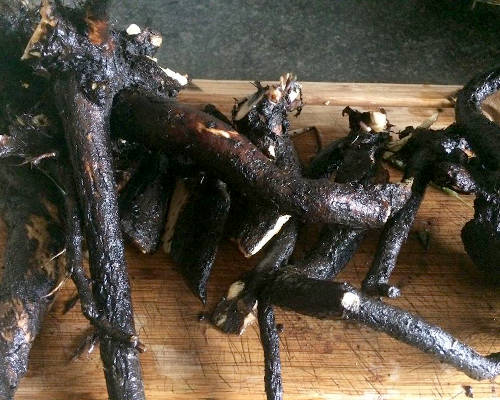 |
| Comfrey root cleaned |
 |
Comfrey root oil
To be used externally for fractures, sprains, bruises, damaged tendons and ligaments, joint aches and pains…
· Take a good few handfuls of fresh cleaned and chopped comfrey root and place in a bowl · Cover in sunflower oil · Place the bowl on top of a pan of hot water · Cover and simmer for 2 hours, making sure the water does not boil dry and wiping any excess fluid from the pan lid. · After two hours take the bowl off the heat and strain. Composting the used root. The root can be very slimy due to the mucilage. · Leave to settle · (This can be repeated for a stronger infusion using the once infused root oil) · Pour into a container taking care to leave any debris or bits of fluid at the bottom.
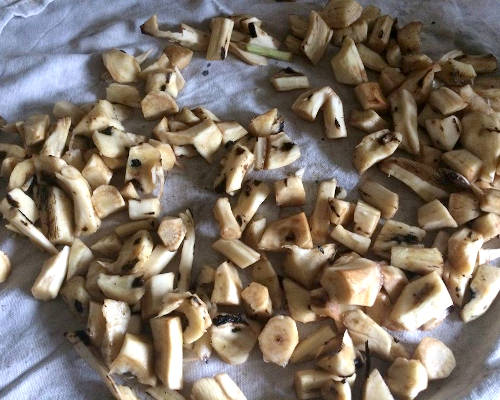 |
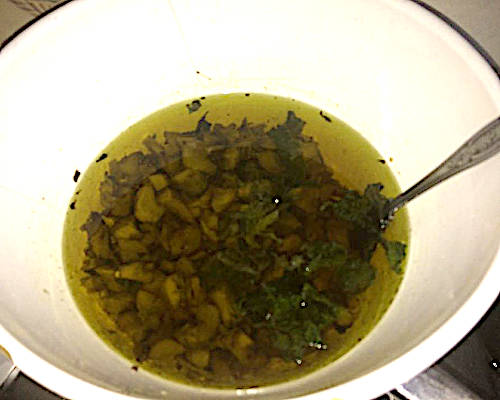 |
| Chopped comfrey root | Infusing the comfrey oil |
 |
 |
Comfrey Salve
Take some of the comfrey oil, measure and place in a clean dry bowl. For every 100mls add 10gs of beeswax or 15mls of Canuba wax (if vegan). Place the bowl in a pan of hot water and heat until the wax melts and pour into clean dry jars and label the salve.
Dandelion- Taraxacum officinale
Often the bane of many gardeners, Dandelion is much more than an innocuous weed. It is a very useful and valuable herb, with all of the plant being useful in some way. Dandelion has jagged leaves like lions teeth earning its French name dent de Lion from which we get Dandelion. Dandelion is a storehouse of nutrients, especially if all parts of the plant are consumed, being full of protein, Vitamin A, a wide range of B vitamins and minerals, and when the roots are fermented they contain Vitamin B12.
Medicinally all parts of the plant are used, the root being an essential part of every herbalist's dispensary. Dug fresh from late autumn to early spring the roots can taste bitter which is a good indication of its actions within the body making it a powerful liver and digestive tonic and a wonderful blood cleanser. It's great to combine it with freshly dug burdock root to make the delicious drink; dandelion and burdock, a classic duo of herbs that help detoxify the liver, cleanse the blood and improve skin problems. Herbalists often use the root to balance hormones, help manage digestive problems such as bloating, flatulence and constipation. Save the fresh young leaves when you have cut them off from the roots as they make a lovely nutritious salad vegetable. They also have a reputation as a kidney tonic, that gives dandelion the folk name of “Wet the bed”. Unlike most pharmaceutical diuretics that deplete the kidneys of potassium, dandelion cleverly replaces it.
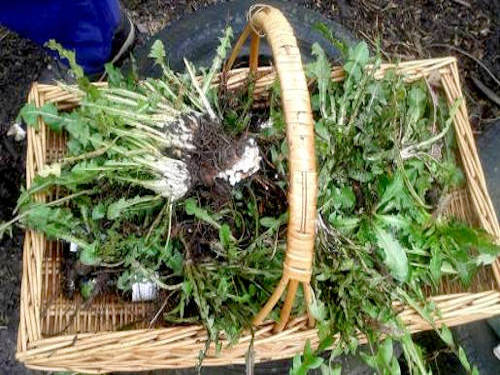 |
 |
| Collecting dandelion roots | Scrubbing dandelion roots |
 |
 |
Dandelion Root Coffee
Dig fresh dandelion roots in the autumn or early spring. Scrub and remove decayed or diseased parts, and chop into small (around 0.5cm) pieces.
Dandelion root coffee can be made in a number of ways. Roots can firstly be dried in a dehydrator, spread thinly over a sheet, or on a very low heat in the oven for a few hours. This reduces roasting time. Roots can then be roasted in the oven, or on the hob in a heavy-based pan, stirring occasionally. They can also be roasted from fresh, although it takes longer this way. When finished, store in an airtight jar in a cool, dark place to prolong shelf life. To use, take 2 tsp per cup water, grind in a coffee grinder or pestle and mortar, place in a cafetiere, add boiling water and leave to infuse for around 5 minutes. Add milk (and honey) to taste, although if sweetened, the therapeutic bitter action is reduced. Drink up to 3 cups per day. Makes a lovely alternative to coffee. Dandelion root can have a laxative effect in some people.
Edwina Hodkinson BSc(Hons) is a qualified medical herbalist and is a member of the National Institute of Herbal Medicine (MIMH)
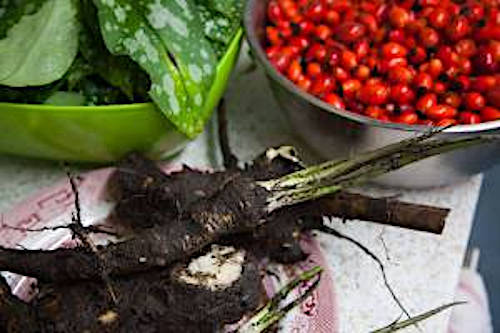 |
 |